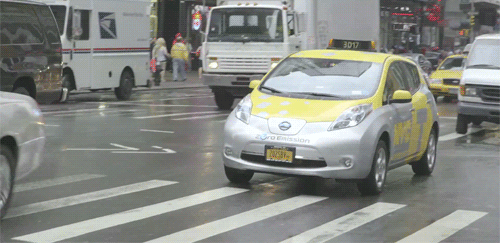Will your next NYC taxi cab be electric?
"When I was in the agency, I always struck up conversations with cab drivers," says "TechKnow" contributor Lindsay Moran. On this week's episode, the former CIA officer takes a look inside New York City's pilot program to introduce electric taxicabs in one of the busiest metropolitan areas in the world.

"This car attracts more attention than a Lamborghini or Rolls Royce would," taxi driver Uppkar Thind says of his new Nissan Leaf, one of six the city is test-running with veteran taxi drivers in the one-year pilot program. "People are not usually phased by anything here, but this car surely draws their attention."
Thind has been driving a cab in New York for 17 years and says he prefers the Leaf -- and avoiding the gas station -- to cars he's driven in the past. Plus, there's some novelty appeal.
"I feel like the Justin Bieber of taxi drivers," he jokes.
Taxi cabs alone release 100,000 tons of carbon dioxide into the air every year. Pending the results of the pilot program, New York City plans to replace 5,000 of the taxicabs that line its streets with electric models by the year 2020. Such a move could reduce the city's carbon emissions by an estimated 30,000 tons.
There are some infrastructure changes necessary to make this change possible. Electric cars have a range of about 80 miles between full charges, and a typical cab driver can reach over 100 miles on a standard shift, necessitating charging stations throughout the city. Currently, there are only two charging stations, both in Manhattan. For the city's plan of 5,000 electric taxis by 2020 to work, they estimate up to 500 charging stations would need to be located throughout the five boroughs.
Thind avoids the range problem by sticking to the central business areas of Manhattan, where the constant braking in heavy traffic helps to recharge the Leaf's battery. "I seek traffic," he says. "The more I'm in traffic, the longer I last."
The program and even the idea of electric cabs is less popular with Thind's peers. "My fellow drivers think I'm stupid for volunteering," he says. But he sees pioneering the program as serving a larger purpose: "Someone needs to try it, everyone will benefit later on."
Thind owns his cab, which made it easier to participate in the pilot program. Cab drivers like Rehan Ahmad, who leases his vehicle from a garage, may be even less willing to embrace the electric concept.
"Charging your vehicle up, I don't know how that system's going to work," Ahmad says. "If you go downtown at any gas station around four or five [o'clock], there's a big line waiting to fill up with gas and 90 percent of them are taxis."
Cab drivers don't want to embrace the new technology for fear that it will cut into their revenue. This is especially true for drivers like Ahmad, who has to make up to $150 a shift for lease payments before he even begins to turn a profit.
"If you lose $30 on an average shift, that could take you below minimum wage on certain days," explains Bhairavi Desai, Executive Director of the New York Taxi Workers Alliance.
However, lease drivers, who have to pay for their own gas in addition to paying for use of the cab, may be the ideal targets for electric taxis.
"Fleets don't pay for fuel," Desai says. "So they don't have a vested interest in this. If this becomes a reality, it's going to be the drivers that make it so."
Watch "TechKnow," Sundays at 7:30PM ET/4:30PM PT on Al Jazeera America.
Error
Sorry, your comment was not saved due to a technical problem. Please try again later or using a different browser.